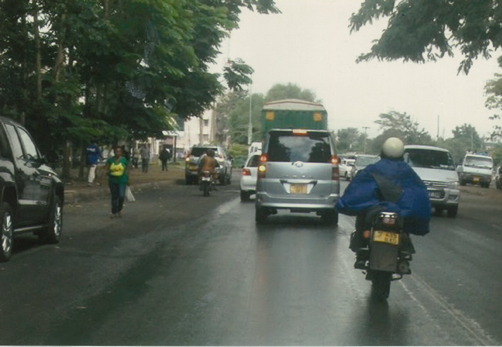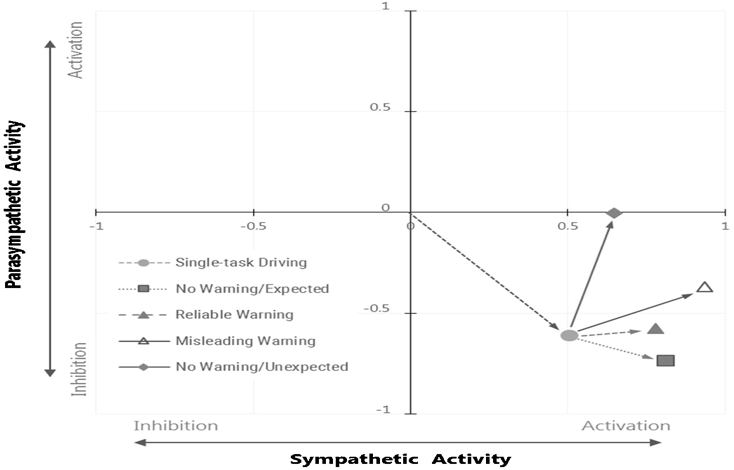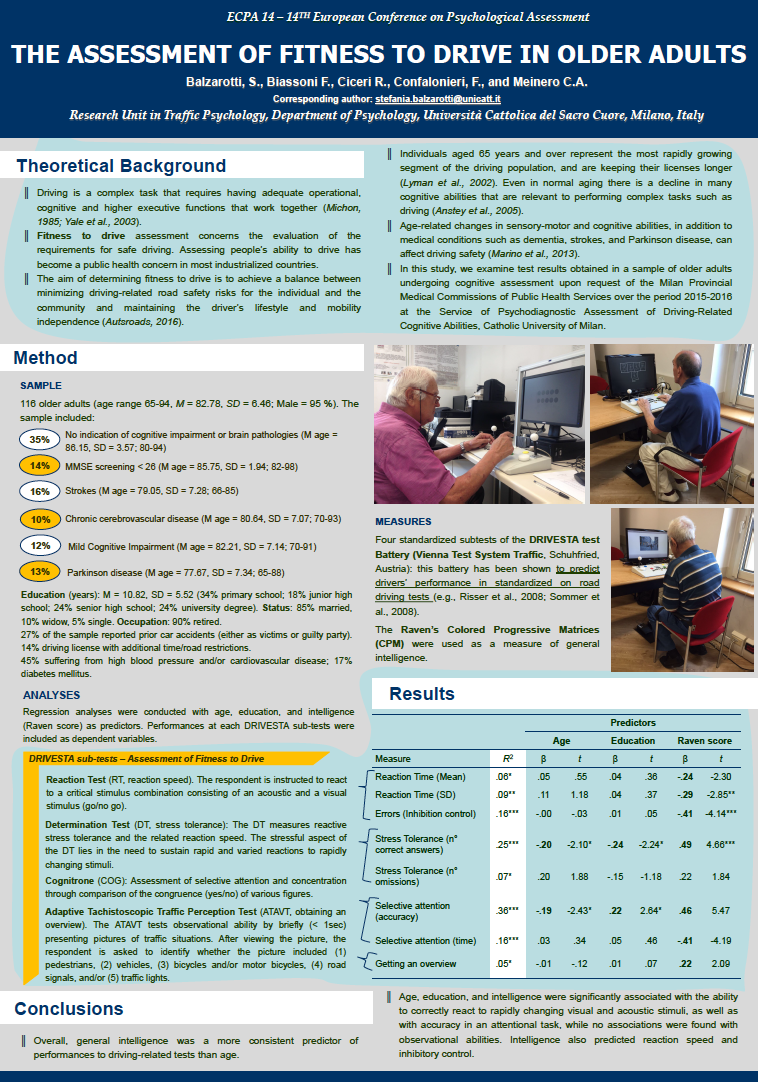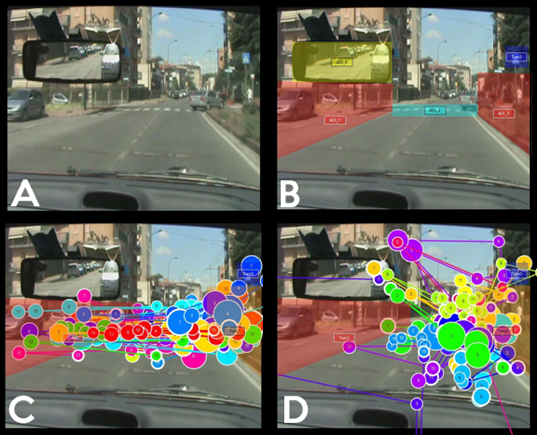- Milano
- Traffic Psychology Research Unity: mobility, safety and sustainability
- Research
- Themes
- Fitness to Drive and Hazard Perception
Fitness to Drive and Hazard Perception
The assessment of fitness to drive in older adults
Assessment and training of driving abiilties
In coll with Richard W. Backs, Ph.D., D.E.E.R. (Driving Evaluation, Education & Research Center) Central Michigan University, MI, US
 |
 |
There is a emerging evidence that simulated “driving-specific” computer-based training programs are more likely to have transfer effects than training that works on general driving-unrelated abilities or that don’t capture the complexities of driving performance. Still controversy about the external validity in a driving context, and the ability to transfer the trained skills into driving behaviours is still present in the scientific community.
The Driver Assessment and Training Suite (DATS) is a tool designed by Driving Evaluation, Education & Research (D.E.E.R.) Center at Central Michigan University, MI, US that aims to apply a cognitive training in simulated “driving-specific” tasks. It is designed to run on a relatively inexpensive laptop so that it is portable, low-cost, and could be used to train driving abilities at home, for older or cognitively impaired drivers who cannot easily reach a rehabilitation facility.
The purpose of the present research is to test Driving Task Battery (DTB) training component of the DATS performance in relation to Wein Task Battery (WTB) (cfr. https://www.schuhfried.com/ ) one of the most commonly used battery task used in Europe to asses driving abilities. In particular we want to test age differences across young, middle-aged, and older drivers using their performance on the Wein Task Battery (WTB) tests to predict their performance on the Driving Task Battery (DTB).
Hazard anticipation and visual exploration of driving and non-driving gamersRisk perception and visual attention while driving are crucial elements for accident prevention and improvement of new drivers' driving behavior. This study investigates how racing videogames could influence the visual exploration patterns of pre-drivers. The performance of players of racing video games without driving licence was compared to the visual exploration patterns of experienced drivers. Attention to specific road elements (e.g., signs) was monitored using an eye-tracking system while participants viewed films of real and virtual scenarios. Results showed that habitual use of racing video games did not lead to more functional patterns of visual attention but sustained the visual patterns typical of novice drivers. M.Ciceri, D. Ruscio (2014), Does driving experience in video games count? Hazard anticipation and visual exploration of male gamers as function of driving experience, Transportation Research Part F: Traffic Psychology and Behaviour, Volume 22, January 2014, Pages 76-85 |
|
The contribution of a safe driving training in educating drivers to risk perception
So far, the influence of safe-driving training on risk perception has received scant attention. The aim of the present work is to examine whether an increase in self-confidence and perception of one's abilities - resulting from a safe-driving training - is associated with an increase in risk perception and awareness. 228 subjects took part to an eight-hours safe-driving training including four driving exercises, simulating risk situations in everyday driving contexts (e.g., someone suddenly crossing the road; driving on slippery road surface). Before and after the training, the subjects were asked to answer a questionnaire assessing risk perception in everyday driving environment (RIPAQ, Risk Perception in Action Questionnaire). Repeated measures ANOVAs showed that after training the participants judged as higher the accident risk associated with some risky behaviors (e.g., “using your mobile while driving”, “not fastening the lifebelt” or “driving at a speed of 60km/h in the city center), but not with others (e.g., “avoiding slowing down next to a cross road”). Data are discussed drawing upon the dual process theory of risk perception: The emotional component of risk seems to be more activated by the safe-driving experience than the analytic one.
F. Biassoni, S. Balzarotti, R. Ciceri (2015). The contribution of safe driving training in educating drivers to risk perception. Procedia Manifacturing, 3, 2251-2258.
Perception of road hazards and cultural beliefs in a Tanzanian Secondary SchoolIn coll. with Mark J. King CARRS-Q (Centre for Accident Research and Road Safety) Queensland University of Technology In Tanzania in 2014, 3,760 people were killed on the roads, and 14,530 were injured (Tanzania Traffic Police, 2015). One barrier to addressing this problem is the fatalistic belief, common in Africa, that a road crash happens ‘because it has to happen’. However, another possible reason is a lack of knowledge about sources of risk when using the road. The purpose of this research was to test a traffic psychology training program designed to improve risk perception regarding road use among school children in a rural area in Tanzania. 211 Students at a school in the Arusha region of Tanzania received a 2-hour lesson developed and conducted by a traffic psychologist about road safety. The effectiveness of training in improving risk perception was measured through a Static Hazard Perception Task (SHPT) administered pre and post lesson. Results show that students identified a higher average number of hazards in the SHPT after the training than before. Notwithstanding limitations of the research, the results strongly suggest that applying a traffic psychology approach to road safety education fostered reflection in the students, about their experiences as road users. Implications for more effective road safety education in Africa are discussed. Perego, P., Biassoni, F., King, M., Ciceri, R. (2017). “The impact of classroom training on road hazards perception in a Tanzanian Secondary School”. International Conference on Safety and Security Engineering, Roma, 6-8 Sept 2017. Abstract book, p. 258. |
 |
  |
Reliability and automation. The role of information about device-specific features in ADAS acceptability
As for many innovative devices that require a novel user-technology interaction, the question of future consumer acceptance is central for the correct utilization of the ADAS device. But since acceptance can be determined only after the direct use of the device, information that aims to promote the use of the safety device should work on improving initial acceptability before use. Acceptability is
the attitude towards a new device before its use, and it can be influenced by information gathered about the device. The aim of the present work is to explore the influence of the quality of information about the device on the acceptability of ADAS. In particular, how information about reliability andlevels of automation of a collision warning system (CWS) affects initial acceptability in naïve potential future buyers of cars equipped with these systems. 527 novice drivers (males and females) rated a CWS presented as fully automated with auto-brake or partially-automated and with vs. without explicit mention to its use limitations. Results show that the quantity and quality of information pertaining to device-specific features can systematically change the initial acceptability towards the safety device. Pleasantness of use and perceived benefits for safety were found to be the most important to the novice drivers.

F. Biassoni, Ruscio, D., Ciceri R. (2016). Limitations and automation: The role of information about device-specific features in ADAS acceptability. Safety Science, 85, 179-186.
Influences of fertility status on risky driving behaviour
The effects of hormones on human behaviour have been extensively studied, but little attention has been paid to the influence of ovarian hormones on risky driving. Twenty-five normally cycling women took part in three sessions, including an ovulatory phase estimation session and two experimental sessions: high vs low fertile phases. These two phases were monitored through a urine-based luteinizing hormone predictor test. In the two experimental sessions, participants were administered the Driving Behaviour Questionnaire and the Vienna Risk-Taking Test. Results showed that women are more risk-averse in their driving behaviour during their high fertile phase. The influence of hormonal fluctuations on self-perception of risk attitude when driving was non-significant. Findings are discussed from an evolutionary perspective.
F. Biassoni, Iannello, P., Antonietti, A., R. Ciceri. (2016). Influences of fertility on risky driving behavior. Applied Cognitive Psychology, 30, 946-952 DOI: 10.1002/acp.3283
Distraction or cognitive overload? Using modulations of the autonomic nervous system to discriminate the possible negative effects of advanced assistance system
The interaction with Advanced Driver Assistance Systems has several positive implications for road safety, but also some potential downsides such as mental workload and automation complacency. Malleable attentionalresources allocation theory describes two possible processes that can generate workload in interaction with advanced assisting devices. The purpose of the present study is to determine if specific analysis of the different modalities of autonomic control of nervous system can be used to discriminate different potential workload processes generated during assisted-driving tasks and automation complacency situations. Thirty-five drivers were tested in a virtual scenario while using head-up advanced warning assistance system. Repeated MANOVA were used to examine changes in autonomic activity across a combination of different user interactions generated by the advanced assistance system: (1) expected take-over request without anticipatory warning; (2)expected take-over request with two-second anticipatory warning; (3) unexpected take-over request with misleading warning; (4) unexpected take-over request without warning. Results shows that analysis of autonomic modulations can discriminate two different resources allocation processes, related to different behavioral performances. The user's interaction that required divided attention under expected situations produced performance enhancement and reciprocally-coupled parasympathetic inhibition with sympathetic activity. At the same time, supervising interactions that generated automation complacency were described specifically by uncoupled sympathetic activation.
Ruscio, D., Bos, A. J., Ciceri, M. R. (2017). Distraction or cognitive overload? Using modulations of the autonomic nervous system to discriminate the possible negative effects of advanced assistance system. Accident Analysis and Prevention, 103, 105-111.



